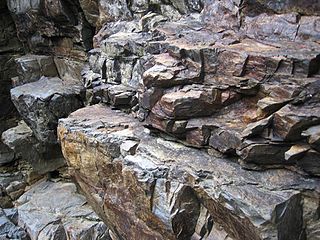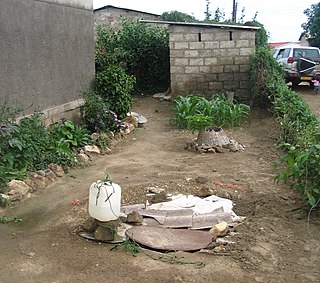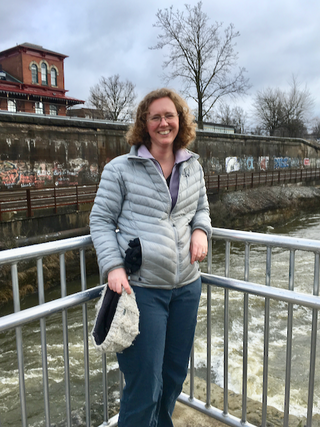Jennifer McIntosh is hydrogeologist and professor of hydrology and atmospheric sciences, university distinguished scholar at the University of Arizona. In 2019 she was named a Geological Society of America Fellow.
Jennifer McIntosh is hydrogeologist and professor of hydrology and atmospheric sciences, university distinguished scholar at the University of Arizona. In 2019 she was named a Geological Society of America Fellow.
Jennifer McIntosh first developed her interest in science during her childhood with family trips from her home near Seattle to Olympic National Park and the Cascade Mountains. In college, a family trip to Yellowstone National Park inspired her interest in the physical, chemical, geological, and biological processes of deep subsurface groundwater.
McIntosh pursued these interests in her higher education by completing her undergraduate studies at Whitman College. McIntosh graduated from Whitman with a B.S. in geology - chemistry. [1] She continued her education at University of Michigan in Ann Arbor, where she earned her M.S. and PhD in geology. [2] [3]
After earning her PhD, McIntosh completed her post-doc in earth and planetary sciences at Johns Hopkins University through the Jane Blaustein Postdoctoral Fellowship. [4] McIntosh began her career in academia at University of Arizona in 2006. McIntosh also served as an adjunct research geologist from 2007-2017 for the United States Geological Survey.
As an associate professor of earth and atmospheric sciences at University of Arizona [5] [6] and an adjunct professor at the University of Saskatchewan, [7] McIntosh has earned recognition for her research, curriculum, and mentorship of her undergraduate and graduate students.
McIntosh is known for her study of topics related to geochemical processes for surface water, ground water, and natural gas. [8] McIntosh conducts multidisciplinary research that integrates hydrology, geochemistry, and microbiology to better understand the fate and transport of fluids beneath the Earth's surface. In subsurface environments, McIntosh studies both deep- subsurface environments and near-surface environments as well as the physical interactions between the two. [2]
McIntosh is the primary author or a coauthor of over 65 peer-reviewed journal publications and has an h-index of 33. [9] [10] Journals including her research include Science [11] , Environmental Science and Technology, [12] Groundwater, [13] Chemical Geology, [14] and Journal of Hydrology. [15]
McIntosh's paper “Competition for Shrinking Window of Low Salinity Groundwater”, an article published in 2018 in IOP Science Environmental Research Letters, has attracted national attention because it addresses new findings about the limitations for US supply of fresh groundwater. [16] [5] The paper maps the depths of separation between fresh and brackish groundwater for 28 sedimentary basins and discusses how this essential resource is being depleted at an alarming rate. [17] The conclusion for the study that there is less available fresh groundwater than was previously estimated has initiated increased awareness about fresh groundwater security. [18]
In 2019, McIntosh was named a Fellow of the Geological Society of America. [19] At University of Arizona, McIntosh was awarded the 2017 University Distinguished Scholar award for her scientific contributions toward teaching and public outreach. [10]
In 2011, the United States Geological Survey (USGS) awarded McIntosh the STAR Award for her research contributions. She also received the "Best Paper Award" for her publication in Geofluids titled “Impacts of Pleistocene glaciation on large-scale groundwater flow and salinity in the Michigan Basin”. [20] [21]
For her contributions as a professor, McIntosh has been recognized with multiple awards for the curriculum and classes she has contributed to both the Hydrologic and Atmospheric Sciences Department and the Geosciences department at University of Arizona. In 2019, McIntosh was awarded the Leon and Pauline Blitzer Award for Excellence in Teaching of Physics. [22] McIntosh has also received the “Award for Excellence at the Student Interface” for three years of teaching including 2011, 2013, and 2017. [23]
McIntosh has been commended for her dedication to teaching earth sciences, and has received multiple awards including the student nominated “Award for Excellence at the Student Interface” in 2011, 2013, and 2017. [23] McIntosh is dedicated to enhancing the education of women in stem. Of the 40 undergraduate and graduate students McInotsh has mentored, more than half are women or underrepresented minorities in STEM. [8]
Due to her knowledge about subsurface systems and their physical interactions, Jennifer also presents at workshops for various public entities including United States Technical Review Board, United Nations Atomic Energy Agency, and the Environmental Protection Agency. [8] McIntosh provided a presentation at the EPA Technical Workshop for the U.S. EPA Hydraulic Fracturing Study in 2015. Her presentation discussed chemical and analytical methods for distinction of subsurface groundwater by comparing the chemical composition of specific isotopes of methane and carbon dioxide. [24] Additionally, McIntosh is an External Advisory Board Member for Energize New Mexico, which is a National Science Foundation funded program designed to stimulate competitive research in STEM fields. [25] [26]
McIntosh has served as an Associate Editor for Water Resources Research since 2013. [27]
Jennifer McIntosh has a husband and two children. [8]
McIntosh is dedicated to enriching the lives of her students. An article courtesy of Parent and Family Programs about McIntosh's personal life and career reported: "As any parent will recognize and understand, watching one’s students go on to build successful careers of their own is the “holy grail” of academic life ...Jen remarks that it is her favorite aspect of the job – helping students build their careers, and (hopefully) balance work and life, whether in academia, industry, or in some other field entirely". [8]

An aquifer is an underground layer of water-bearing material, consisting of permeable or fractured rock, or of unconsolidated materials. Aquifers vary greatly in their characteristics. The study of water flow in aquifers and the characterization of aquifers is called hydrogeology. Related terms include aquitard, which is a bed of low permeability along an aquifer, and aquiclude, which is a solid, impermeable area underlying or overlying an aquifer, the pressure of which could lead to the formation of a confined aquifer. The classification of aquifers is as follows: Saturated versus unsaturated; aquifers versus aquitards; confined versus unconfined; isotropic versus anisotropic; porous, karst, or fractured; transboundary aquifer.

Hydrogeology is the area of geology that deals with the distribution and movement of groundwater in the soil and rocks of the Earth's crust. The terms groundwater hydrology, geohydrology, and hydrogeology are often used interchangeably, though hydrogeology is the most commonly used.
Fossil water, fossil groundwater, or paleowater is an ancient body of water that has been contained in some undisturbed space, typically groundwater in an aquifer, for millennia. Other types of fossil water can include subglacial lakes, such as Antarctica's Lake Vostok. UNESCO defines fossil groundwater as "water that infiltrated usually millennia ago and often under climatic conditions different from the present, and that has been stored underground since that time."
The Jackson School of Geosciences at The University of Texas at Austin unites the Department of Earth and Planetary Sciences with two research units, the Institute for Geophysics and the Bureau of Economic Geology.

Earth science or geoscience includes all fields of natural science related to the planet Earth. This is a branch of science dealing with the physical, chemical, and biological complex constitutions and synergistic linkages of Earth's four spheres: the biosphere, hydrosphere/cryosphere, atmosphere, and geosphere. Earth science can be considered to be a branch of planetary science but with a much older history.

Groundwater pollution occurs when pollutants are released to the ground and make their way into groundwater. This type of water pollution can also occur naturally due to the presence of a minor and unwanted constituent, contaminant, or impurity in the groundwater, in which case it is more likely referred to as contamination rather than pollution. Groundwater pollution can occur from on-site sanitation systems, landfill leachate, effluent from wastewater treatment plants, leaking sewers, petrol filling stations, hydraulic fracturing (fracking) or from over application of fertilizers in agriculture. Pollution can also occur from naturally occurring contaminants, such as arsenic or fluoride. Using polluted groundwater causes hazards to public health through poisoning or the spread of disease.
Lynn Walter Gelhar is an American civil engineer focusing in hydrology and is currently Professor Emeritus at Massachusetts Institute of Technology. He is recognized for pioneering research in stochastic subsurface hydrology, has leading research in the area of field-scale contaminant transport experiments, and has extensive experience on the hydrologic aspects of nuclear waste disposal.
Aradhna Tripati is an American geoscientist, climate scientist, and advocate for diversity. She is a professor at the University of California, Los Angeles (UCLA) where she is part of the Institute of the Environment and Sustainability, the Department of Earth, Planetary, and Space Sciences, the Department of Atmospheric and Oceanic Sciences, and the California Nanosystems Institute. She is also the director of the Center for Diverse Leadership in Science. Her research includes advancing new chemical tracers for the study of environmental processes and studying the history of climate change and Earth systems. She is recognized for her research on climate change and clumped isotope geochemistry. She studies the evolution of atmospheric carbon dioxide levels and the impacts on temperature, the water cycle, glaciers and ice sheets, and ocean acidity.

Noam Weisbrod is a Hydrology Professor at the Department of Environmental Hydrology and Microbiology of the Zuckerberg Institute for Water Research (ZIWR), which is part of the Jacob Blaustein Institutes for Desert Research (BIDR) at Ben-Gurion University of the Negev (BGU). Weisbrod served as director of ZIWR from 2015 to 2018. In 2018 he became director of BIDR and was reelected for a second term in summer 2022.
Kimberly A. Prather is an American atmospheric chemist. She is a distinguished chair in atmospheric chemistry and a distinguished professor at the Scripps Institution of Oceanography and department of chemistry and biochemistry at UC San Diego. Her work focuses on how humans are influencing the atmosphere and climate. In 2019, she was elected a member of the National Academy of Engineering for technologies that transformed understanding of aerosols and their impacts on air quality, climate, and human health. In 2020, she was elected as a member of the National Academy of Sciences. She is also an elected Fellow of the American Philosophical Society, American Geophysical Union, the American Association for the Advancement of Science, American Philosophical Society, and the American Academy of Arts and Sciences.
Shirley Jean Dreiss (1949–1993) was an American scientist working in the fields of hydrology and hydrogeology. After gaining her PhD from Stanford University, she joined the faculty of the University of California at Santa Cruz, where she became Professor and Chair of the Department of Earth Sciences. She made important contributions to the understanding of water flow through karst aquifers and fluid flow in subduction zones. At the time of her early death in a car accident, she was studying the groundwater system of Mono Lake in California. She was awarded the Birdsall Distinguished Lectureship from the Geological Society of America, which was renamed the Birdsall-Dreiss Distinguished Lectureship after her death.
Adina Paytan is a research professor at the Institute of Marine Sciences at the University of California, Santa Cruz. known for research into biogeochemical cycling in the present and the past. She has over 270 scientific publications in journals such as Science, Nature, Proceedings of the National Academy of Sciences, and Geophysical Research Letters.

Anne Jarvis Jefferson is an American hydrologist who specializes in watershed hydrology, urban hydrology, and hydroecology. As of 2023, she is the Patrick Chair in Watershed Science and Planning at the Rubenstein School of Environment and Natural Resources at the University of Vermont. Previously she was an associate professor at Kent State University in the Department of Geology, which became the Department of Earth Sciences.
Holly Michael is an American hydrogeologist and Associate Professor of geology at the University of Delaware's College of Earth, Ocean, and Environment.

Kamini Singha is a professor in the department of Geology and Geological Engineering at the Colorado School of Mines, where she works on questions related to hydrogeology.

Audrey Hucks Sawyer is an American hydrogeologist and Assistant Professor of Earth Science at Ohio State University. Her work has focused on quantifying the role of groundwater - surface water interactions in transporting nutrients, contaminants, and heat in rivers and coastal settings. Sawyer has won multiple awards, including the National Science Foundation CAREER Award in 2018 and the Kohout Early Career Award in 2016.
Hendratta Ali is a geoscientist who does work in hydrology, aqueous geochemistry, exploration geology and equity geoscience. Her home institution is the Department of Geosciences at Fort Hays State University. She was awarded the 2021 Geological Society of America Randolph Bromery award and Fort Hays State University President’s Distinguished Scholar Award. Ali is a native of Cameroon.
Beth L. Parker is a hydrogeologist and professor at the University of Guelph who has made exceptional contributions to the science and practice of Contaminant Hydrogeology and the protection of groundwater from contamination, that have been adopted internationally to protect water supplies in Guelph and many other communities.
Karen H. Johannesson is an American geochemist and professor in the School for the Environment at the University of Massachusetts Boston and the Intercampus Marine Sciences Graduate Program of the University of Massachusetts System. She teaches geochemistry and has expertise in environmental geochemistry, biogeochemistry, trace element speciation, geochemical modeling, chemical hydrogeology, reaction path and reactive transport modeling.

Coastal Hydrogeology is a branch of Hydrogeology that focuses on the movement and the chemical properties of groundwater in coastal areas. Coastal Hydrogeology studies the interaction between fresh groundwater and seawater, including seawater intrusion, sea level induced groundwater level fluctuation, submarine groundwater discharge, human activities and groundwater management in coastal areas.